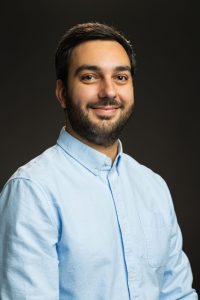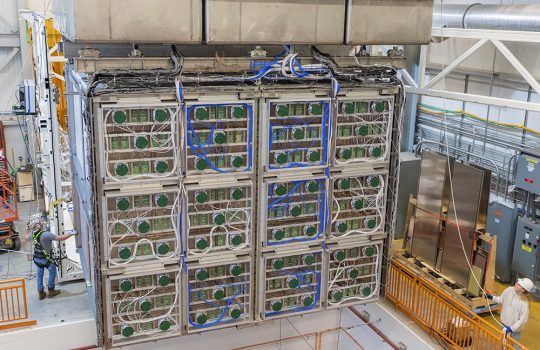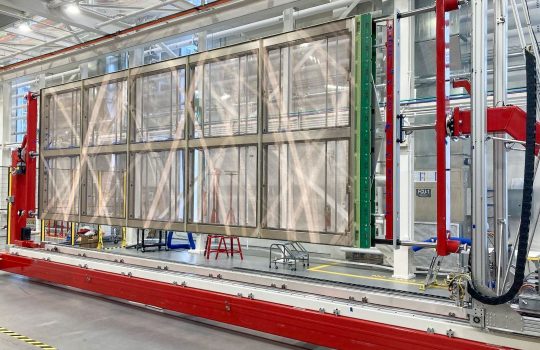The creative ideas of Fermilab research fellow Marco Del Tutto have brought neutrino detection in the Short Baseline Near Detector to the next level with innovations, such as removing unnecessary shielding; exploiting the connection between neutrino energy and neutrino direction when the neutrinos are produced in a beam; and researching an idea to add magnetic fields to the detector.
Del Tutto is this year’s recipient of the Universities Research Association Tollestrup Award for Postdoctoral Research. He was chosen for his “innovative contributions to searches for new physics using liquid argon detectors.” This annual award, named after Fermilab scientist Alvin Tollestrup, recognizes outstanding work by postdoctoral scientists that is either conducted at Fermilab or with Fermilab scientists.
“I often observe that the best Tollestrup nomination packets read like a particularly strong tenure case, and Marco’s is no exception,” said Michael Mulhearn, chair of the URA Tollestrup Award Committee.
Looking at neutrinos from a new angle
Del Tutto’s history with Fermilab goes back nearly a decade. He participated in a summer program in 2014 during his master’s degree education at the University of Rome. That summer, he was assigned to work on the NOvA experiment.

Fermilab research fellow Marco Del Tutto received this year’s URA Tollestrup Award for Postdoctoral Research. Photo: Ryan Postel, Fermilab
“That’s how I started neutrino physics, and I loved it from that moment,” said Del Tutto. “I love the collaboration of the people, I love the physics, and so I decided to continue in this field.”
He then earned his doctoral degree at the University of Oxford with work on the MicroBooNE experiment, where he made the first measurements of the experiment’s muon neutrino interactions.
After six months as a postdoctoral fellow at Harvard University, Del Tutto came back to Fermilab in 2019 as a Lederman postdoctoral fellow. In the years since, his focus shifted from MicroBooNE to the upcoming SBND. This detector, one of three that make up Fermilab’s Short-Baseline Neutrino program, will be the closest to the neutrino source, the Booster Neutrino Beam. The three detectors will measure how neutrinos change flavor as they travel through space.
“SBND is going to have unprecedented statistics, lots of neutrino events to look at, a lot of physics to do,” Del Tutto said.
Del Tutto applied a technique, called Precision Reaction Independent Spectrum Measurement, or PRISM, to SBND, using the same detector to sample neutrinos at many different energy distributions at the same time. It can be done by observing neutrinos that approach the detector at different angles from the neutrino beam’s axis.
“Marco Del Tutto has pioneered the Short-Baseline Neutrino Detector program through his contributions to the SBND-PRISM technique,” said URA president John Mester. “His creativity, ingenuity and innovation have also helped advance the cosmic ray background analysis.”
The neutrino beam isn’t perfectly focused, and the neutrinos can hit the detector at different angles, with the energy distribution of the neutrino depending on its angle. As a result, the detector can simultaneously measure a variety of neutrinos with different energy levels at different locations on the detector.
“You have this for free because you’re not moving the detector, you’re not changing the detector, you’re just looking at different regions of the detector itself,” Del Tutto said.
Innovative techniques and experiments, such as PRISM, are crucial to the search for signs of new information beyond the Standard Model, the current best understanding of particle physics, according to Del Tutto.
“We study neutrino interactions, we study neutrino oscillations, but on top of that, we need to find what is missing in the Standard Model,” he said. “Now, we have a lot of new theories that we can probe, and it turns out that we can probe many of those with the detectors that we already have. We need to be creative and come up with new analysis techniques that will allow us to explore these new physics models.”
To make the most out of PRISM, Del Tutto founded a collaboration between experimentalists and theorists to come up with ideas of what to look for with this technique. These objectives include looking for possible dark matter particles and sterile neutrinos, a hypothetical new type of neutrino.
“It’s very easy for this type of communication between experimentalists and theorists to be lacking or not there at all,” Del Tutto said. “Starting this from the beginning makes everything easier: We can provide to the theorists what we can do with the experiments, and they can identify theories that we are actually able to test with the experiment.”
Sorting the positive from the negative
Another idea Del Tutto has developed to improve detectors’ capabilities is incorporating a magnetic field into liquid argon time projection chambers, or LArTPCs.
LArTPCs are full of highly pure argon that is kept cold enough to be a liquid. Neutrinos interact with other matter very rarely because they have no charge, making them impossible to see themselves. However, a LArTPC can detect the charged particles that are the product of a collision between a neutrino and an argon atom, such as a proton and a muon in the case of muon neutrinos. When that happens, the charged particles unleash electrons along their trajectories, which are then forced via an electric field to drift sideways to a series of wires on one side of the detector. When the electrons interact with the wires, they send signals that come together into a 3-D reconstruction of the neutrino-argon collision.
LArTPC detectors can reveal almost everything about a neutrino collision except what charge each particle has, such as the difference between an electron and a positron. But if a magnetic field is added to the detector, these oppositely charged particles will curve in opposite directions. The curved path of the particles would also depend on the energy of the particle, making it possible to measure the particle’s momentum. To take advantage of this phenomenon, Del Tutto looked for a way to add a magnetic field to a LArTPC.
“What will really make LArTPCs the ultimate detector, not only for neutrino physics but also for many other analyses, is the addition of a magnetic field,” he said.
Adding a magnetic field would also make it easier to detect antimuons that would be produced by switching the neutrino beam to an antineutrino beam. The magnetic field would help distinguish antimuons from the background noise of muons. This technique can also separate pairs of electrons and positrons that overlap, which is one predicted sign of some new particles.
Del Tutto’s creative work with neutrino detectors hasn’t just benefited the science itself. In 2020, he figured out a way to streamline the construction of SBND.
Detectors like SBND are prone to background noise due to the constant flow of cosmic rays, such as muons and neutrons, that rocket through Earth’s atmosphere from space. Instead of putting the detector far below the Earth’s surface — an expensive solution — the plan was to keep the detector on the surface and cover it in three meters of concrete.
However, when Del Tutto joined the experiment in 2019, how effective those three meters of concrete would be with cosmic interference. He ran simulations to see how cosmic rays would interact with the materials in the detector. His study confirmed that muons from cosmic rays pass through the concrete anyways, and neutrons are so low energy that they produce identifiable signals that can be ignored.
“Three meters of concrete will not stop muons coming from cosmic radiation: you will need hundreds of meters to stop a muon,” Del Tutto said.
A benefit of not using the concrete when it’s not needed, apart from the lower cost, is to ensure that the detector is more easily accessible for repairs.
Del Tutto brought his results to the Short-Baseline Neutrino program’s oversight board, and the decision was made to remove the concrete shielding from the SBND’s design.
“Marco has made remarkably impactful contributions to his experiments, through widespread contributions that range from the highly practical, such as showing that expensive concrete shielding would be ineffective, to the highly ambitious, such as magnetizing a LArTPC,” Mulhearn said. “Marco’s pioneering efforts with the SBND-PRISM technique have made the SBND physics program dramatically more ambitious.”
As of early June, Del Tutto started a new position at Fermilab as a Wilson fellow. He continues to work on the magnetized LArTPC project, with plans to use a magnet on a small detector to test the concept on a small scale. Beyond that, further work with SBND is on the horizon for Del Tutto when construction on the detector is completed.
“We’re going to have data from SBND pretty soon, so I’m looking forward to analyzing it,” he said. “I’m mainly interested in neutrino physics, but my main focus will be what kind of new models and new physics we can explore with this data. It’s going to be really exciting.”
Fermi National Accelerator Laboratory is supported by the Office of Science of the U.S. Department of Energy. The Office of Science is the single largest supporter of basic research in the physical sciences in the United States and is working to address some of the most pressing challenges of our time. For more information, please visit science.energy.gov.



